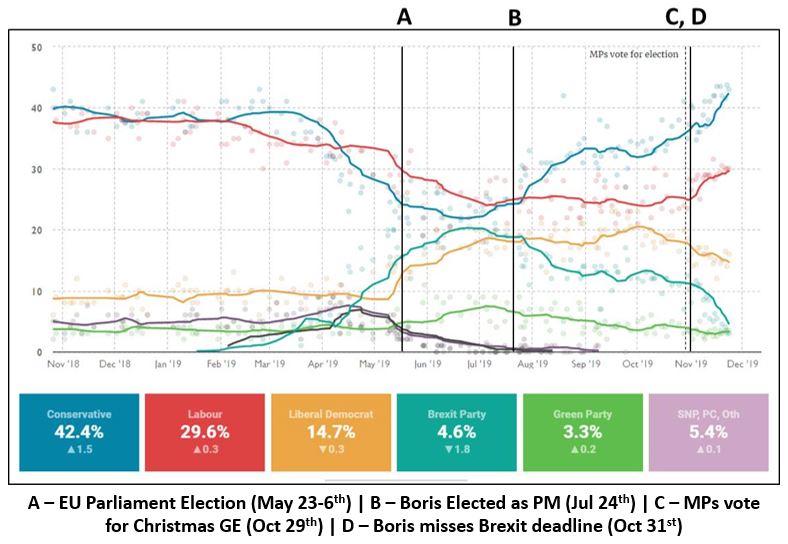I first shared this content as a speech at The Salvation Army’s London HQ as part of their Public Affairs team’s presentation on the upcoming election. Here, I’ve converted it into blog form.
Who will govern after December 12th? The first Winter General Election since 1923.
Let’s look at a poll of polls – an average of all published polls like this one by Britain Elects. We’re looking at it because individual political events are less important than trends, like how this year’s unfolded and what we can learn from previous elections.
I’ll briefly tell you what’s happened in the last year, and what’s likely to happen in the next few weeks.
What’s happened (in the last year)?

Four major events demonstrate both the volatility, but also the rigidness of voter intentions.
1) In the European Parliament Elections up to May 26th the smaller parties were rising stars. The Brexit Party rose from January and the Liberal Democrats from May to win 1st and 2nd place respectively (30.5%/19.6%) – as the Tories and Labour lost out.
2) But when Boris became Prime Minister on July 24th, the Tories took 5% back from the Brexit Party by mid-August. Labour and the Lib Dems steadied off but Labour had been hammered for months on its Brexit stance, declining 7% since the start of May.
Then there were two big events in a few days…
3) On October 29th MPs voted for a General Election, right before –
4) Boris breaks his own sacred January 31st Brexit deadline. But… It’s not immediately catastrophic – Brexiteers mostly still trust Boris to get the job done. It shows that some events are less influential than we might expect on voting intentions, and that when major events coincide, it can mix up the expected results on public opinion.
Moving forward, the main two parties have both gained around 4% since October when the election was called, whilst the Liberal Democrats have joined the Brexit Party in decline (also around -4%).
What will happen (in the next 10 days)?
We have two weeks (ish, now ten days) until polling day – What are the influencers?
Election debates? More horrific gaffes? No, because generally the echo chambers we live in, our strong opinions and party allegiances mean that most back the leaders they already support.
For example, YouGov’s Snap Poll after ITVs debate recorded that Tory and Labour voters in the 2017 General Election were 88/86% most likely to back their respective party leader.
With the Tories in a 12 point lead (now 10.6) – the golden question is… How many undecided voters will Labour win over?
Well, a survey by Ipsos MORI in November showed that 6 in 10 who voted Liberal Democrat in the last election ‘may change their mind’, two thirds of whom to Labour. And there are over 875,000 more new registered voters than the four weeks prior to the last General Election time (remember the ‘Youthquake’?), two thirds of whom are under 35 and more likely to vote Labour.
Nonetheless, the Tory lead is so strong that a Tory majority remains the most likely outcome.
A Labour majority is possible, say if the Tories lost 7% and Labour gained 6% (now more like 5% and 6%). But more likely is a hung parliament where no party gets a majority leading to a coalition or minority government.
Throwback (to the last 3 General Elections)
Looking back at the last four weeks, of the last three General Elections, it’s unlikely Labour can catch up. LSE’s Dr Joe Greenwood made a valuable insight in a blog post on November 18th that I’ve paraphrased below. Full credit to him for the following chart.
Figure 1: Change (%) in average polling levels of support for parties over the final four weeks of the campaigns.
2010: Saw ‘Cleggmania’ with an 8% boom in the Liberal Democrats after Nick Clegg’s performance in a TV debate;
2015: Whilst 2015 saw no meaningful change in voting intentions between any of the parties.
2017: Now with two weeks (ish) to go Labour would have to beat the 5% growth they saw in the last four weeks of the 2017 General Election.
Meanwhile, the Tories would have to start declining, but at the moment they’re still rising with retained Brexit Party support (although less so as of today). As in 2015, voting intentions could hold steady.
Closing remarks
A Conservative government is the most likely outcome. However, another hung parliament remains a very real possibility.
This article has demonstrated both the volatility and rigidity of voting intentions, and has emphasized the importance of long term trends over hot media events of the day, to best inform ourselves for this months vote.
At this point I drew the audiences attention to YouGov’s Multilevel Regression and Post-stratification (MRP) constituency model that was published that evening. It was the only projection to correctly predict a hung parliament and otherwise totally unforeseen swings from Tory strongholds like Kensington and Canterbury to Labour in 2017.
Its results have since been published predicting a massive Conservative victory, ironically triggering Dominic Cummings into warning against Tory complacency, fearing small ‘c’ conservatives might feel Corbyn has no chance, enshrining them with enough confidence to vote for Farage or Jo Swinson instead, or just not show up on election day at all.
Reflections since speech day
Nevertheless, since I shared this content as a speech at The Salvation Army’s HQ to inform third sector staff about the Christmas Election, the gap between the Conservatives and Labour has thinned (around 1.5%).
Boris was replaced by a melting ice sculpture by Channel 4 for shunning Britain’s first climate debate and he continues to be shamed in the media for refusing an interview with the BBC’s Andrew Neil.
The Conservative ascent has plateaued and Labour continues to climb.
So on polling day… when we shuffle into those booths, the issue i’m pondering is will those Northern voters picked up by the pollsters as Brexit Party-goers’ really abandon Labour?
And at the election after next… will the Tories regret alienating small ‘c’ conservative moderates for not-so-loyal Northern Brexiteers if Labour figure out a more relatable leader?
Featured Image Credit: https://unsplash.com/photos/-Qf9JKLysUg

